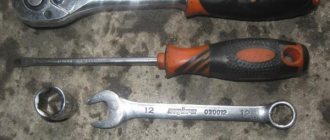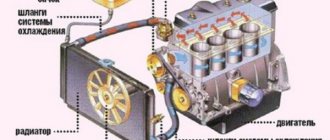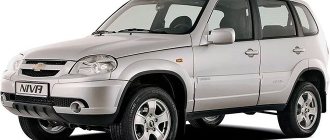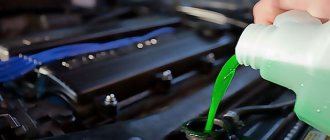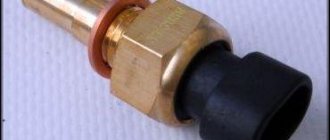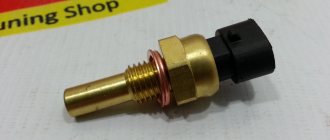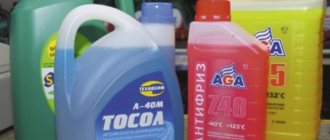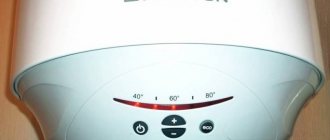February 29, 2016 Lada.Online 189 961 13
According to the maintenance regulations for Lada cars, the coolant (antifreeze, antifreeze) should be changed every 75 thousand km. mileage or after 5 years, whichever comes first. At this moment, it is important to choose the right liquid correctly, then there will be no comments about it for the same amount of time.
Let's start with the names - Antifreeze and Antifreeze
In fact, previously it was the same thing. In our former Soviet Union, antifreeze was produced under the name “Tosol”; there were also names “Lena”, “Siberia” and others. All these are antifreeze or just coolant. But since in the union there was nothing else besides “Tosol” antifreeze, therefore the word “Tosol” became a common noun and manufacturers long ago began to write simply the word “Tosol” on the cans. Now let's forget about the words Antifreeze and Antifreeze and call it all coolant and start looking at its composition.
There are currently 4 classes of coolants. And to understand what is in the canister from the seller, look for the following markings: G11, G12, G12+, G13. It is from this marking that you can understand what is in the canister and what you need. But not by the name “Antifreeze” and especially by color. Remember, color does not matter, since this is not an additive and has an indirect relation to the composition - it is just a dye on which the color of the liquid, and not its capabilities, depends. Therefore, different manufacturers can produce coolant of any color that the customer desires. And the customer (for example, a car manufacturer) can order a certain color constantly.
What is antifreeze and what does Antifreeze have to do with it?
As soon as the first cooling system appeared, it was filled with the most accessible and efficient coolant on the planet - water. The water was good for everyone, but had one drawback. At sub-zero temperatures, it froze and, expanding, tore apart ancient cylinder blocks, radiators and heads . Therefore, back in the late 20s, they began to add ethylene glycol to the water, which did not freeze, but turned into a plastic porridge in the cold. There is little good in this, but there is no particular problem either - old cast-iron engines did not suffer from freezing.
They called this thing antifreeze, an antifreeze liquid.
Antifreeze or antifreeze, which is better?
Everything would be fine, but in the early 60s, engines with aluminum blocks and parts made of complex alloys began to appear. It was on these parts and on aluminum that ethylene glycol had a fatal effect - corrosion devoured not only new cylinder blocks, but also pump impellers, copper and brass elements of the cooling system. In the USSR they were not particularly worried about this, since all the cars had cast iron blocks and were not afraid of corrosion.
Antifreeze was developed in the USSR specifically for the Zhiguli car.
The composition was called Antifreeze because it was developed in the Department of Organic Synthesis Technologies, and the prefix “ol” is part of the chemical name of the substance.
one conclusion from here - Antifreeze is an antifreeze that was developed in the USSR in the 60s specifically for VAZ and over time its name became a household name.
Video which is better, antifreeze or antifreeze
More about markings
Class G11
Antifreezes marked G11 are antifreezes based on silicates and inorganic additives. Used for cars up to 1996. And now the main thing is that Antifreeze has the same composition! Therefore, remember, coolants Antifreeze and Antifreeze brand G11 are the ONE AND THE SAME!
G11 antifreeze (Tosol) is designed for older cars with a large cooling system. They create a protective film throughout the cooling system that protects parts from corrosion, but this protection has a drawback - this protective film reduces thermal conductivity. Therefore, in a modern car with thin cooling system channels, G11 is not suitable, because engine cooling deteriorates. In addition, the boiling point of G11 antifreeze is 105 degrees. The maximum service life of such coolants is 2-3 years or up to 50-80 thousand km. mileage
Class G12
G12 antifreezes have a completely different composition of additives than G11 (Antifreeze) - these are carboxylate organic compounds. Used on high-speed, heat-loaded vehicles. Boiling point is 115-120 degrees. G12 does not create a protective film throughout the entire system, but only acts on areas of possible corrosion. Therefore, the thermal conductivity of G12 antifreeze is higher than that of G11. The service life of the G12 is 5 years or 250 thousand km. mileage
Class G12+
G12+ antifreeze is slightly different from G12, the same carboxylate organic antifreeze. We can say that this is the next generation after the G12, used on modern cars. The operating method and service life are similar to G12.
Class G13
G13 antifreeze is the newest generation of coolant; it is no longer based on ethylene glycol like G11, G12, G12+, but on propylene glycol. This antifreeze is less toxic and decomposes faster, i.e. causes less harm to the environment during disposal or leakage, but is also more expensive. Used for high-performance engines. Engines of sports cars, motorcycles, etc. for engines operating in extreme conditions. They say they don’t make it in the CIS countries yet (at the time of writing this article (2014)) due to its high cost, but I’ve already seen it on sale, although I didn’t pay attention to the manufacturer.
Antifreeze
This blue liquid is known to all Soviet car enthusiasts. It is most often used on domestic cars and is nothing more than antifreeze, which uses traditional additives. Everyone thinks that this liquid comes in only one color, but there are two options for antifreeze:
- blue with a freezing threshold of about -30;
- red (pink) with operating temperature up to -50.
Chemical additives help the fluid form thin films on surfaces. With whom she comes into contact.
The advantages of antifreeze include its low price and popularity on domestic cars (many units work with it without failures, including the VAZ-2110).
At the same time, the classic “anti-freeze” has several disadvantages:
- impossibility of use on high-temperature engines (boils at 110 degrees);
- the need to change antifreeze after two to three years;
- high activity of the composition.
Domestic cars for the most part work properly on it, but foreign cars (especially new ones with composition sensors) may not even start if you put traditional antifreeze in the tank.
G11 – green antifreeze
At the beginning, it is worth noting that not only green-colored liquids are produced with the “G11” marking, they can be painted blue or even yellow, but recently manufacturers most often produce antifreeze of a grassy color. It copes well with small pockets of corrosion, which are neutralized with the help of additives.
In terms of its properties, G11 can be equated to antifreeze. It has one more small drawback - over time, the deposited additives begin to crumble and clog the small channels of the cooling system. The film that forms on the walls of the components reduces the heat removal from the engine, which has a more detrimental effect on it.
G12 – red antifreeze
This “anti-freeze” product uses fewer chemical additives; when modernizing the composition, manufacturers replaced them with organic ones (mainly carboxylic acid). Their main advantage is that a protective film is not formed and, accordingly, heat removal is not impaired. This antifreeze has improved characteristics:
- heat is removed more efficiently;
- there are no deposits on the walls of the system, therefore nothing crumbles;
- long service life - up to 60 months;
- The liquid fights corrosion areas.
With all these advantages, the G12 has one significant drawback - during its use, automatic maintenance of the cooling system is not carried out. This antifreeze best protects systems in which parts are made of brass and copper, but it does not have a pronounced positive effect on aluminum.
G13 – purple antifreeze
In 2012, the newest antifreeze composition appeared on the markets - G13, which is colored purple in most cases. The base used for it is propylene glycol, an alcohol that is less toxic and active. The formula of this antifreeze is designed specifically to reduce the negative impact on the environment. At the same time, the additive complex was left unchanged - these are carboxylic acid and silicate compounds.
Many of the foreign cars of recent years operate only on this composition, since their system has a special sensor installed that measures the density of the “anti-freeze” and determines its composition. The VAZ-2110 does not have such a unit, so you can also use G13 in it, if you don’t mind paying the maximum price for it (antifreeze and other antifreezes are much cheaper).
Is it possible to mix
Despite the fact that classes G11, G12, G12+ contain ethylene glycol, different manufacturers use different types of additives. Therefore, I still would not recommend mixing even G12 and G12+. And even more so, you cannot mix G11 and G12 - a coagulation process will begin, which may result in a sediment in the form of flakes. The only thing is that if you have an emergency on the road and there is nothing at hand or in the nearest store, then you can mix G12 and G12+, as well as G11 and G12+, but under no circumstances should you mix G11 and G12! And as soon as possible, repair the car, drain the mixture, rinse the system several times with water and then fill in with fresh antifreeze. Also, if you want to switch from one class of antifreeze to another, then also flush the system before replacing. How I flushed the system, there is an entry in my blog.
Antifreeze in a VAZ 2110: how many liters are needed and how to change it
Antifreeze is a special liquid designed to cool a car engine. It is poured into the expansion tank of the system, located under the hood of the car. The fluid requires periodic replacement, since after a certain period of engine operation it loses its original properties. Therefore, young car enthusiasts are interested in how much antifreeze is in the VAZ 2110 cooling system.
After a certain mileage and operation of the VAZ 2110 car, it is necessary to carry out a technical inspection, monitor the level of oil and coolant in the system. After a certain period of operation, all lubricants and coolants lose their original technical and operational characteristics and require replacement. Therefore, before replacing the coolant, you need to find out how much antifreeze is in the cooling system of the VAZ 2110.
Many inexperienced car enthusiasts, when replacing antifreeze or antifreeze in a car's cooling system, fill in 5-6 liters of fluid and make sure that it has reached the maximum level in the expansion tank, consider this sufficient and close the hood of the car. This is their big mistake, since the antifreeze has not yet had time to completely fill the system. You need to wait about five minutes until the liquid level in the tank drops significantly. Accordingly, you will need to add more coolant.
This procedure must be done several times, only then will it be clear how many liters of antifreeze are in the VAZ 2110 cooling system. It is necessary to add fluid until its level stops at one mark, which should be above the minimum and below the maximum level. Not adding enough antifreeze or antifreeze can cause the engine to overheat and fail. It is also impossible to overfill coolant, since when heated it tends to increase in volume.
After pouring antifreeze (antifreeze), you need to perform the following steps::
- close the expansion tank cap;
- start the engine and wait until it warms up before turning on the fan;
- turn off the engine and let it cool down;
- Check the coolant level in the tank and top up if necessary.
A VAZ 2110 needs to be filled with approximately 8 liters of coolant. This is a rather important procedure on which the life of the car engine depends.
What are coolants?
“Anti-freeze” is necessary for effective engine cooling. They must have the highest boiling point, since in the summer the engine often overheats. In addition, in most of our country, in winter the temperature drops to critical levels; in order for the cooling system to function normally, you need to take liquid with a freezing threshold at the lowest possible temperatures, this is especially important in Siberia and the northern territories.
Antifreeze and antifreeze have the same base - ethylene glycol mixed with distilled water. In its natural form, this alcohol boils at a temperature of 196 degrees and freezes at -11. When mixed with distilled water, you can increase the freezing threshold to -35, or even -65. This is enough to use liquids in the cooling system throughout Russia.
To increase the effectiveness of anti-freeze agents, additives are added to them, which perform another important function - they help protect pipes, tubes, radiator and engine block from the aggressive effects of liquid. If you pour a composition of two components (ethylene glycol and distilled water) into the system, then in the next month you will have to change the entire cooling system and even repair the engine. Thanks to additives, which occupy up to 20% of the volume of any antifreeze, the composition becomes more perfect.
Instructions for replacing coolant
Most owners of domestically produced cars prefer to carry out repairs and maintenance of their own cars themselves. Therefore, inexperienced car enthusiasts are interested in how to change antifreeze on a VAZ 2110. First, you need to drain the used fluid.
Draining used antifreeze:
- First you need to install the vehicle in a place convenient for performing work. In this case, the car must be level, or you can raise its front part, but not the rear.
- The terminal is removed from the battery so that if liquid accidentally gets on the exposed wire, a short circuit does not occur.
- If the car uses an injector, the ignition module is removed, otherwise it will interfere with unscrewing the drain plug from the cylinder block.
- To quickly drain the antifreeze from the system, the cap from the expansion tank is also unscrewed.
- Now you need to completely unscrew the plug on the engine cylinder block using a spanner (spanner).
- When the liquid has completely drained from the block, it is advisable to wipe the engine with a rag, precisely those areas where the used antifreeze came into contact during the draining process. There is no need to screw the plug back yet.
- Now the radiator cap is unscrewed and the liquid is drained into a separate container.
All waste from the cooling system has been completely drained. Now you need to put all the plugs in place and tighten them carefully. You can add new antifreeze or antifreeze.
Top 10 antifreezes
Liqui Moly Langzeit Kuhlerfrostschutz GTL12 Plus 5L
This product was developed by German specialists. It is a blue-colored liquid that is well suited for all types of engines, regardless of their materials of production: cast iron, aluminum alloys, and so on. Antifreeze will efficiently cool an engine equipped with an intercooler.
Antifreeze retains all its performance qualities in an extended temperature range - from -40 to +110 degrees. The service life of the liquid ranges from 2 to 5 years depending on the conditions of use. It complies with all existing international standards and is recommended for most engines.
Advantages:
- It removes excess heat well from the heating elements of the motor, preventing it from overheating;
- With its help, a protective layer is created on metal parts, which protects them from oxidation;
- Acts as an additional lubricant for the pump, which will extend its service life;
- Does not corrode plastic and rubber elements;
- Thanks to this product, you can use the car in a wide range of temperatures.
More: Top 10+ best DVRs with radar detector, how to choose a combo device?
Flaws:
- High price;
- Very low boiling point - +109 degrees.
Liqui Moly Langzeit Kuhlerfrostschutz GTL12 Plus 5L
Toyota Long Life Coolant Red Concentrate 1L
This is concentrated antifreeze - a red-colored liquid. Can be used not only in Toyota cars, but also in a number of other models. Mixing with other coolants is strictly prohibited. Before filling, antifreeze must be diluted with distilled water in equal proportions. The resulting coolant will withstand temperatures down to -37 degrees, which is quite enough for the middle zone. During operation it does not form sediment.
Advantages:
- Reliably protects the car engine, regardless of the materials from which it is made;
- Capable of reliably removing excess heat, increasing the stability of all vehicle systems even under heavy loads;
- Works well with seals and pipes made of plastic or rubber.
Flaws:
- It can be difficult to find;
- High price.
Toyota Long Life Coolant Red Concentrate 1L
Liqui Moly Motorbike Langzeit Kuhlerfrostschutz GTL 12 Plus 1L
The main area of use of this coolant is the engines of bikes and motorcycles, but it is also allowed to be poured into car engines. It is perfectly compatible with both cast iron alloys and aluminum-based alloys, from which all modern engines are made. Sold in a completely ready-to-use form, does not need to be mixed with distilled or softened water.
Advantages:
- Prevents the car's cooling system from freezing;
- Reliably protects against corrosion;
- It removes heat well, preventing the engine from boiling;
- Designed for optimal performance with motors made of aluminum alloys.
Flaws:
- Not detected.
Liqui Moly Motorbike Langzeit Kuhlerfrostschutz GTL 12 Plus 1L
TCL Power Coolant Green -40 2L
This is one of the best antifreezes made in Japan. It is made on a carboxylate or organic basis - it fully complies with all international standards and requirements, in particular G12/G12++.
It contains special components that minimize the impact of friction on vehicle elements. This allows you to extend the life of vehicle parts, primarily the engine and pump. It is produced on the basis of a number of organic acids.
Advantages:
- Operates over a wide temperature range – from -40 to +110 degrees;
- Creates a protective film on the engine that prevents corrosion and other destructive processes;
- The composition contains only organic substances that do not form sediment during operation.
Flaws:
- When the temperature drops, it becomes too viscous, which makes circulation through the cooling system difficult.
TCL Power Coolant Green -40 2L
AGA Z40 5L
This coolant can be used in engines of trucks and cars of various brands. At the same time, the engine can run on both gasoline and diesel fuel, and shows itself very effectively in forced engines. Does not need replacement within 150 thousand kilometers. Antifreeze additionally protects the pump seals from destruction and protects all metal parts from corrosion and cavitation processes.
More: Top 10 best fog lights
The liquid is colored red and is compatible with any antifreeze and antifreeze, regardless of color, provided that they are made on the basis of ethylene glycol. If necessary, up to 10% distilled or soft water can be added to the composition.
All added additives are of high quality; they ensure reliable operation of the fluid in the temperature range from -40 to +123 degrees.
Advantages:
- Low price;
- Compatible with most other coolants;
- High boiling point;
- Easy to find on sale;
- Cleans the engine well from contaminants.
Flaws:
- The freezing temperature is slightly higher than stated.
Antifreeze AGA Z40
AGA Z42 10L
This is one of the best green antifreezes; it can be used in both domestic and foreign engines. It realizes its characteristics most effectively in turbocharged engines that operate at high speeds that occur during acceleration or at high speeds.
Antifreeze retains its beneficial qualities at different pressures and in a wide temperature range - from -42 to +123 degrees. It contains a fluorescent dye that lights up under ultraviolet light, making it easier to find leaks.
Advantages:
- Perfectly protects metal engine parts from hypothermia or overheating;
- Low freezing point;
- High anti-corrosion and lubricating qualities;
- Reliable protection against cavitation;
- Versatility;
- Compatible with most engines.
Flaws:
- Formation of sediment during operation.
Antifreeze AGA Z42
AGA Z65 5L
This is a universal coolant that can be used on trucks and cars, regardless of what brand of engine is installed in the vehicle. Manufacturers recommend using such antifreeze in engines equipped with turbocharging, intercoolers, and also if the car is used in winter conditions in areas with little airflow, which often happens in urban areas.
The manufacturer guarantees that the product can operate reliably without replacement for 5 years or 150 thousand kilometers. The coolant contains organic additives that provide high heat capacity and the ability to operate in the temperature range from -65 to +132 degrees.
Advantages:
- Long period of operation;
- A significant amount of additives;
- Good degree of corrosion protection.
Flaws:
- During operation, sediment forms quite quickly.
Antifreeze AGA Z65
Sintec Unlimited 5L
Antifreeze is produced using the latest bipolar technology based on high-quality ethylene glycol. In terms of its performance properties, this is one of the best compositions, so it rightfully occupies one of the first places in the ranking of antifreezes. It has been subjected to a number of functional tests to confirm its high quality. The freezing point of the liquid is lower than what the manufacturer claims - antifreeze begins to crystallize at -45 degrees, which allows it to be used even in the most severe climatic conditions.
More: Top 20 best radar detectors [yearcode]
Advantages:
- The composition contains very active inhibitors that neutralize rust;
- The freezing point is much lower than indicated on the packaging;
- Can be used for more than 5 years.
Flaws:
- It was not revealed.
Antifreeze Sintec Unlimited
Felix Energy G12+ 1L
This is a domestically produced composition that is suitable for absolutely any vehicle: with a forced engine; with engines equipped with turbocharging and used in rather harsh climatic conditions, with an intercooler and so on.
Antifreeze allows the vehicle to be used in a temperature range from -40 to +50 degrees, while the liquid itself retains its performance properties from -48 to +130 degrees. This product blocks rust areas, forming a layer no more than 1 micron thick on them.
Advantages:
- Expanded scope of application;
- High boiling point;
- The anti-corrosion additive performs a large number of functions in the engine;
- Acceptable price.
Flaws:
- Crystallization begins at a higher temperature than stated by the manufacturer.
Antifreeze FELIX Energy
Lukoil Antifreeze G12 Red 5L
One of the best antifreezes intended for VAZ cars and other domestic cars. The liquid is produced using carboxylate technology, which ensures a low freezing point. It is used exclusively in closed engine cooling systems of cars and trucks and is capable of operating at temperatures down to -40 degrees.
Thanks to this product, it is possible to provide reliable protection of the entire cooling system from freezing, scale formation or overheating. Antifreeze can even be used for engines made from aluminum alloys that are subject to high loads during operation. It does not have a destructive effect on rubber hoses and plastic parts.
Advantages:
- Can be mixed with antifreeze of any color;
- Increased thermal conductivity;
- Efficiency of application.
Flaws:
- Not identified.
Antifreeze LUKOIL Red G12
Coolant filling procedure
It’s worth checking first how much antifreeze is needed in a VAZ 2110 for 16 antifreeze valves. After this, you can begin work.
- The coolant drain hose is removed from the throttle valve. To do this, you first need to loosen the clamp holding it. The hose should not be thrown on the ground; it must be suspended from something nearby.
- The liquid must be poured slowly and observed whether it flows from any hose. If there is a leak, quickly put the hose back in place. After this, add antifreeze to the required level and close the plug.
After filling the cooler, it is important to observe the operation of the engine for a while. If it gets very hot, and cold air comes out of the switched on stove, then an air lock has formed in the system, which must be removed.
Optimal coolant option
When you have figured out how to replace antifreeze on a VAZ 2110 (2112), it is important to choose the optimal fluid option. Many car enthusiasts only use expensive antifreeze, considering it to be of higher quality. For VAZ cars, it is quite possible to use a cheap domestic product - antifreeze, the characteristics of which were developed specifically for these cars.
Owners of domestic cars respond positively to Felix brand antifreeze. It is sold in canisters of 5 and 10 liters, and smaller containers. It is profitable to purchase liquid in a 10 kg container - it is cheaper, and after replacing the used antifreeze, there is still liquid left for refilling.
Didn't find the information you are looking for? on our forum.
